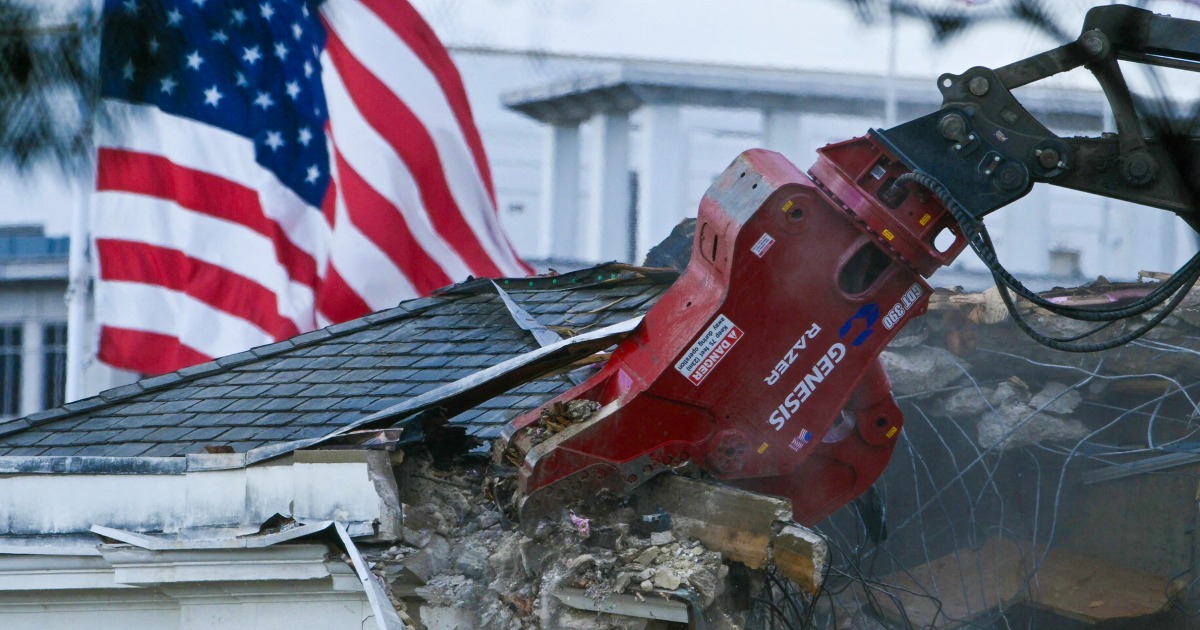The entire East Wing of the White House will be demolished “within days,” according to two Trump administration officials.
The demolition is a significant expansion of the ballroom construction project from what President Donald Trump announced this summer.
“It will not affect the current building,” Trump said on July 31. “It will be close to the building but not touching it, and it is a tribute to the existing building, which I am the biggest fan of.”
The New York Times first reported the extent of the demolition.
A White House official told NBC News that “the entire East Wing” will eventually be “modernized and rebuilt,” but acknowledged that the process is fluid.
“The scope and size of the ballroom project could always vary throughout the process,” the official told NBC News.
The East Wing was significantly expanded during Franklin D. Roosevelt's presidency in 1942. It is connected to and part of the White House complex and was typically used by the First Lady and her staff.
Construction on the ballroom began last month. Trump said it would hold up to 900 people, and last week he said the total price tag would be about $250 million, which he and private donors would cover. However, Trump said Wednesday that the price tag for the ballroom is “approximately $300 million.”
A White House official told NBC News via email that “all historic components of the East Wing, such as elements of… [Rosalynn] Carter's original First Lady's Office was preserved and preserved under the supervision of the White House Executive Residence and the National Park Service with assistance from the White House Historical Association. Plans for future use are in place.”
The National Trust for Historic Preservation, a nonprofit created by Congress to preserve historic buildings, warned administration officials in a letter Tuesday that the proposed ballroom “will overwhelm the White House itself.”
“We respectfully request that the administration and the National Park Service pause demolition until plans for the proposed ballroom have gone through the legally required public review processes,” Carol Quillen, CEO of the National Trust, said in a statement.
The White House argues that it is not required to submit plans for review by the National Capital Planning Commission because only demolition — and not technically construction — has begun.
The U.S. Commission of Fine Arts, the National Capital Planning Commission and the D.C. State Historic Preservation Office are the regulators that would traditionally be involved in approving major renovations at the White House, according to a person familiar with the matter.
But the White House is ultimately exempt from its binding authority and approval process, the person said, because it is located at 1600 Pennsylvania Ave. is a symbolically unique property.
The Trust for the National Mall, as a nonprofit partner of the National Park Service, oversees private donations in support of the ballroom project. The design and construction will be led by Trump himself together with McCrery Architects.
So far, Trump has made significant changes to the Rose Garden, the Oval Office, the Cabinet Room and the Palm Room. He also installed two huge flagpoles on the property.
Some experts questioned how transparent the administration was about the ballroom construction project.
Bryan Clark Green, an architectural historian and former staffer at the National Capital Planning Commission, said in an interview: “As far as norms and customs go, administrations have always been through this [approval] to gain buy-in and ensure the public sees the process and is not surprised by the design. The point of the review process is to improve the design.
“So you had that [Trump] Statement in the summer that this will have no impact on the East Wing. But obviously it is. A public trial would have avoided such shocks and surprises.”
Priya Jain, a member of the Society of Architectural Historians, said: “It seems as if she [the White House] plan to submit their proposal to the National Capital Planning Commission. However, on regular federal projects, consultation takes place before anything is demolished.”
Construction plans were not submitted to the National Capital Planning Commission in advance, but a White House official claimed they would be available “soon, when the time comes.”
It is unclear what this time frame is. The NCPC is affected by the government shutdown.
This week, construction crews were seen tearing down the east wing's facade, sparking criticism from Democrats, historians and even some Republicans.
The White House called Tuesday's riot a “contrived outrage” by “crazy leftists and their fake news allies” in a press release.
The critics, the White House said, “are excited by President Donald J. Trump's visionary expansion of the White House to include a grand, privately funded ballroom.”
The release said the proposed ballroom is “a bold, necessary addition that reflects the storied history of improvements and renovations by commanders in chief to maintain the Chief's Residence as a beacon of American excellence.”
It was noted that numerous other presidents had renovations and construction done at the site. “FACT: For more than a century, U.S. presidents have been renovating, expanding and modernizing the White House to meet the needs of the present,” it said, pointing to specific examples.
Trump hosted a dinner at the White House last week to thank the project's donors.
Comcast Corp., the parent company of NBCUniversal, was added to the list of top donors. It's unclear how much Comcast and other donors contributed; Alphabet, YouTube's parent company, agreed last month to donate $22 million to the project as a settlement in a lawsuit brought by Trump against the online video platform.
